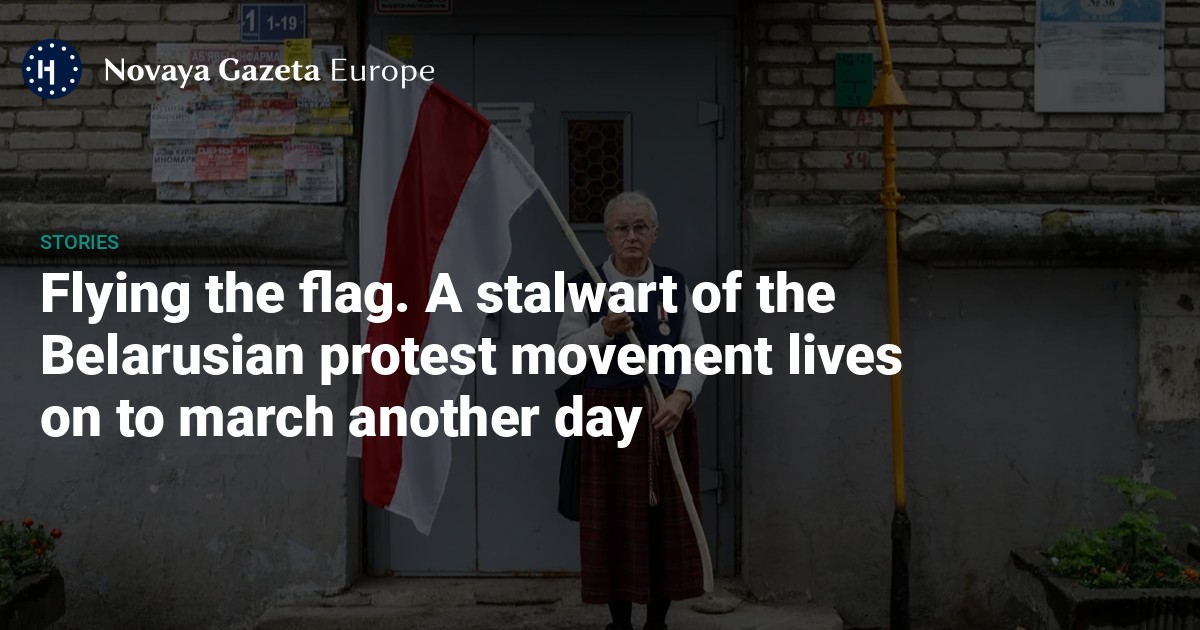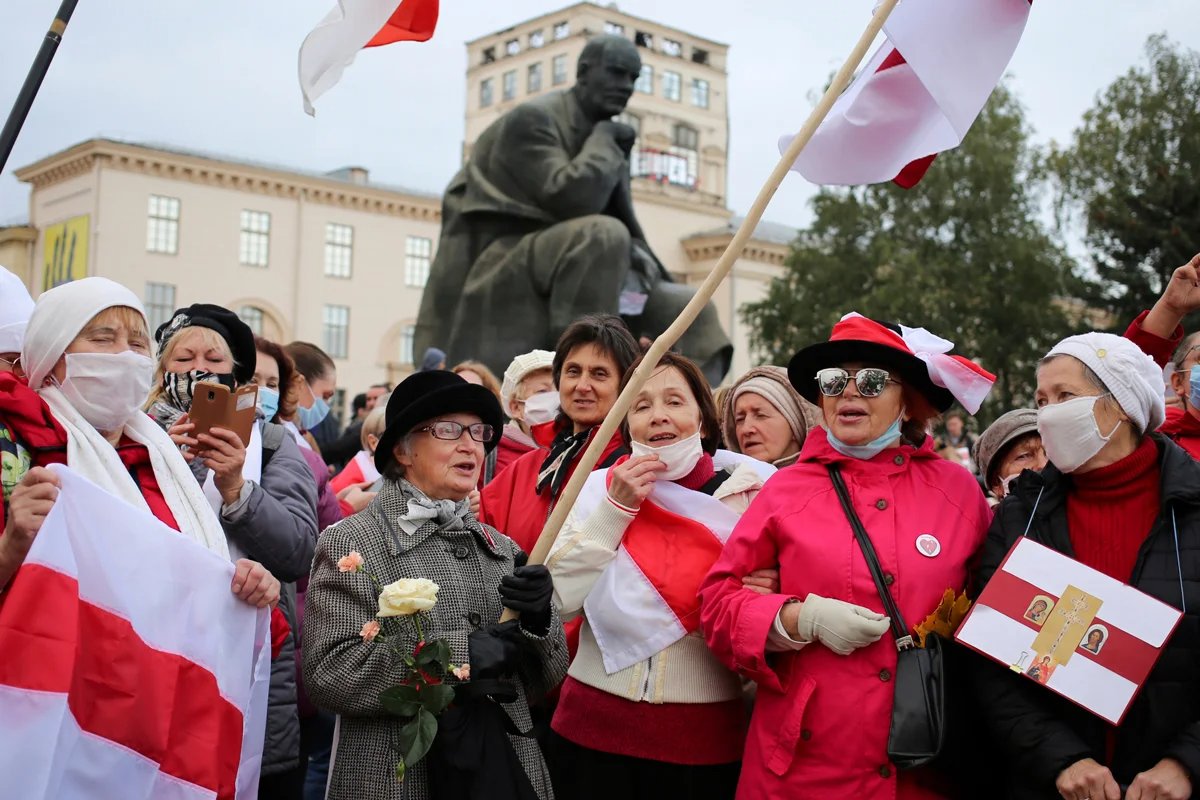



In a rare display of leniency, a court in the Belarusian capital Minsk last week acquitted 78-year-old veteran activist Nina Bahinskaya who had been charged with violating protest procedures for wearing a badge on the streets of Minsk in 2024 in the white-red-white colours of Belarus’s post-independence flag.
As she walks out of court free to march another day, carrying a protest flag she will no doubt have sewn herself, we take a look at the life of a woman who has been demonstrating longer than anybody in Belarus.
“Just make sure you don’t take Nina Bahinskaya away! If you take Nina Bahinskaya away, there’ll be no opposition,” Belarusian dictator Alexander Lukashenko said in the autumn of 2020 at a meeting with officials. “Yes, her views are radically at odds with ours. But she’s a woman of conviction, and she should never be taken off the street. She’s part of the scenery.”
Bahinskaya is a mainstay of the Belarusian protest movement. If there was a protest in Minsk, she was on it.
As always, though, Lukashenko’s words meant nothing. Bahinskaya was taken off the street. Frequently. She has had her flag taken out of her hands, been issued large fines, and had her property confiscated. Each time, she sewed another white-red-white Belarusian flag — which Lukashenko replaced with a version of the Soviet-era flag in a sham referendum in 1995 — and went back out onto the streets with it. This time, though, Bahinskaya was acquitted of “repeatedly violating the procedure for organising or holding mass events”.
Belarus criminalised such activity in 2021 as a response to the widespread protests that erupted before and after the 2020 Belarusian presidential elections which saw Lukashenko re-elected for his sixth consecutive term.

Bahinskaya protests the results of the presidential election, Minsk, 26 October 2020. Photo: AP Photo / Scanpix / LETA
In 2020, Bahinskaya and her flag became more than just a symbol. They became a fashion. She was photographed for Italian Vogue, and Time wrote about her too. Her apartment jostled with journalists from all over the world. Young people came to protests just to get a photo with her.
Bahinskaya is a mainstay of the Belarusian protest movement. If there was a protest in Minsk, she was on it. And when there wasn’t, Bahinskaya was out on the street with her flag anyway. She was the protest. She didn’t look for support or join parties or movements. It was just her and her flag.
It is a rainy day with a howling wind in the autumn of 2019. My friends and I are collecting signatures ahead of “parliamentary elections” to put forward a candidate to oppose Lukashenko. Experienced protesters that we were, we used the opportunity to go to people’s homes, campaign and put our point of view across. Standing with a white-red-white flag in the middle of the city and not suffering any consequences was a big deal in and of itself.

Police detain Nina Bahinskaya, Minsk, 19 September 2020. Photo: TUT.by / AP Photo / Scanpix / LETA
“Looks like it’s going to be dead today,” one friend says, when, suddenly, a flag appears around the corner. It’s Bahinskaya. Come rain or shine, there she is. The picket was a success, perhaps because she was there. People hurrying home with umbrellas stopped when they saw the flag.
They listened to her story, how she dreamt of getting a bike as a child and then, when she got one in eighth grade, how she immediately joined a cycling club. How she met a coach there by the name of Anatol Bahinsky, whom she married when she was 30. How they raised two children, and how he died of a serious illness after 30 years of married life, shouting in delirium: “The police are breaking in!”
Bahinskaya cannot say how many times she has been detained.
Bahinskaya is a geologist by profession, and worked at the Belarusian Academy of Sciences. Before that, she’d learnt to be a seamstress, and has been sewing clothes and flags for herself ever since.
The veteran activist has been protesting as long as the country has. She first protested in November 1988, when Minsk residents marched to Kurapaty, the site of a 1937 mass shooting. But while many stopped protesting as the years went by, she carried on.

Nina Bahinskaya faces down the riot police, 28 September 2020. Photo: Jana Shnipelson / Flickr(CC0)
Bahinskaya cannot say how many times she has been detained. She has been held at the infamous Akrestsina pretrial detention centre several times, but the courts have always ended up issuing fines, never a custodial sentence. The pensioner can ill afford them. She once estimated they must amount to over €20,000, which would take her at least 50 years to pay off in full. But even if she could pay, she wouldn’t on principle.
In 2016, the state confiscated her washing machine, microwave and dacha, a small plot of land in the Minsk region. The latter was to be sold to cover the fines. Friends and I agreed at the time to chip in, buy the dacha and return it to its rightful owner. But Bahinskaya categorically forbade us from doing so: “Do you want your money to pay security force salaries? Don’t be part of this!” This was her form of civil disobedience.
For a long time, no one bought the dacha. No one wanted to be sullied by it. It eventually sold at auction in 2022 for 727 Belarusian rubles, just under €300. A drop in the ocean, when compared to all the fines. Either 20% or 50% of her pension — depending on changes to the collection system — goes on fines.

Bahinskaya protests the results of the presidential election, Minsk, 19 October 2020. Photo: EPA
In 2022, Bahinskaya had new legal restrictions imposed on her. She now couldn’t hunt or drive boats or a car, and telephone companies and internet providers were banned from providing her with their services. An ordinary person with self-preservation instincts wouldn’t do what she does, even less so for decades at a time.
But Bahinskaya hadn’t just become the symbol of the protests in 2020. That was only when the international community discovered her. In 2006, photographer Yauhen Attsetski photographed a petite, slight woman carrying a flag on a long pole in front of a police cordon at protests which were also violently dispersed. The photo worked its way around the media, then took on a life of its own, and Belarusians thus got to know their countrywoman.
And even though she has her back to the photographer, people in Minsk would soon recognise her by her flag. By the summer of 2020, the hundreds of thousands who took to the streets all knew her face.
The Russian government has banned independent media. We were forced to leave our country in order to keep doing our job, telling our readers about what is going on Russia, Ukraine and Europe.
We will continue fighting against warfare and dictatorship. We believe that freedom of speech is the most efficient antidote against tyranny. Support us financially to help us fight for peace and freedom.
By clicking the Support button, you agree to the processing of your personal data.
To cancel a regular donation, please write to [email protected]
VPNovaya
Help Russians and Belarusians Access the Truth
